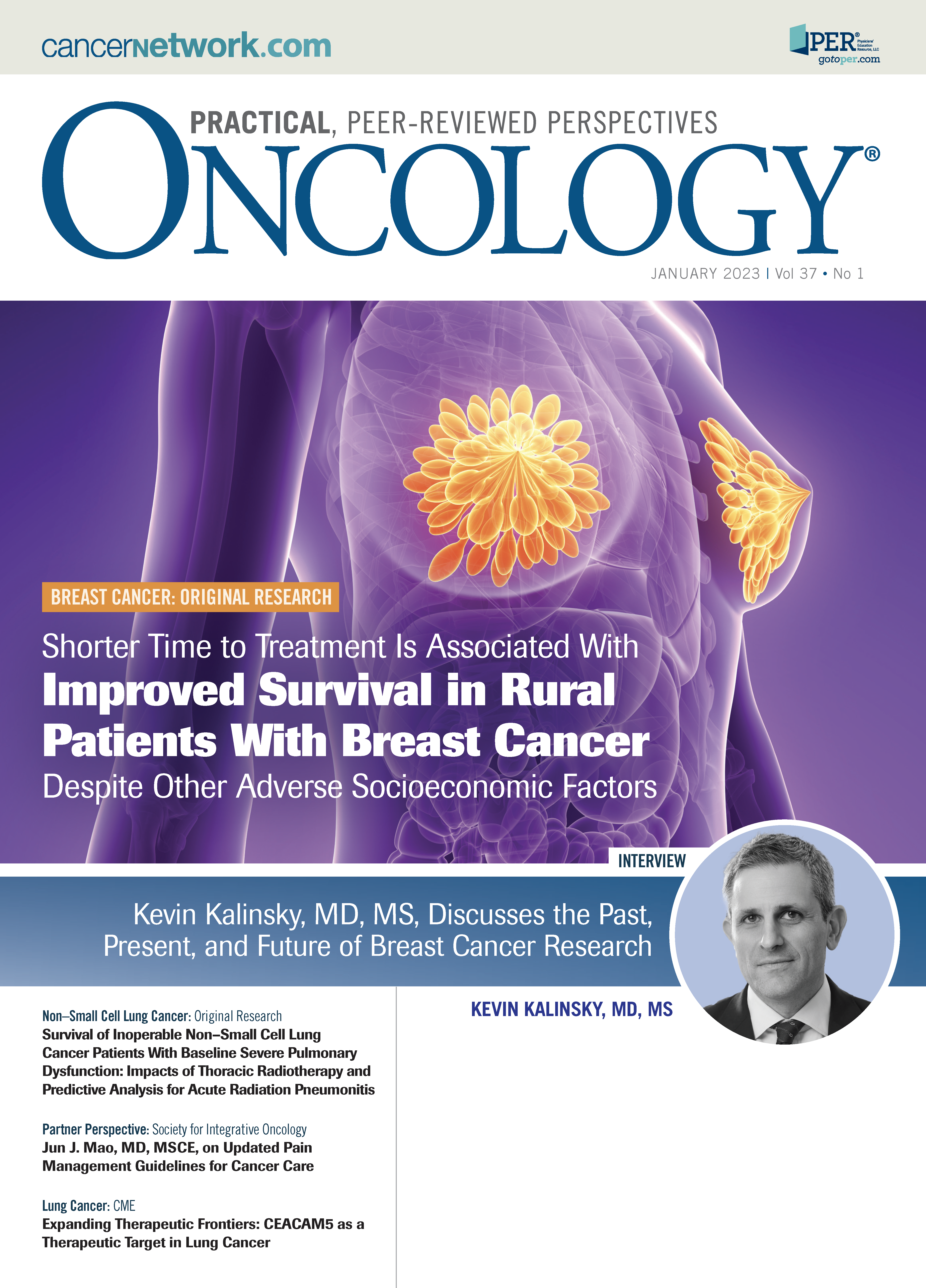Shorter Time to Treatment Is Associated With Improved Survival in Rural Patients With Breast Cancer Despite Other Adverse Socioeconomic Factors
Minh-Tri Nguyen, MD, and colleagues investigate the association between time to treatment, socioeconomic status, and clinical outcomes among rural and urban patients with breast cancer.
ABSTRACT
BACKGROUND. Cancer care in rural areas poses unique challenges, including access and proximity to care. This study examined differences in time to treatment initiation (TTI), a potential surrogate for access, and predictors of overall survival (OS) between rural and nonrural patients with breast cancer.
METHODS. Women with stage I to III breast cancer diagnosed between 2004 and 2012 in facilities accredited by the National Cancer Database of Commission on Cancer (CoC) were included. Differences between rural and nonrural patients in demographics, disease and treatment characteristics, socioeconomic factors, and TTI were assessed by χ2 test. The effects on OS of age, insurance status, cancer center type, community median income, percentage of the community who had not graduated from high school, and TTI were assessed using Cox models.
RESULTS. The study population was composed of 1,205,031 patients, 18,417 (2%) of whom were rural. Compared with nonrural patients, rural patients were more likely to be older, to be White, to receive care at nonacademic centers, to have government insurance or annual income less than $38,000, and to be less educated (P < .0001). Rural patients also had shorter median TTI (3 vs 4 weeks; P < .0001), which was associated with improved OS (P < .0001), and were more likely to have TTI less than 4 weeks and less than 8 weeks (P < .0001 for both). Shorter TTI (both <4 weeks vs 8 weeks and 4-8 weeks vs >8 weeks) was also associated with improved OS (P < .0001 for both). After adjusting for disease stage and demographic-, socioeconomic-, and treatment-related factors, rural status was associated with improved OS compared with nonrural status (HR, 0.92; 95% CI, 0.89-0.96; P < .0001).
CONCLUSIONS. Despite several adverse demographic and socioeconomic factors, rural patients with breast cancer with access to CoC-accredited facilities had significantly shorter TTI and better OS compared with nonrural patients. The clinical significance of this is undetermined; however, these data suggest that improving TTI can mitigate disparities in rural cancer care.
Oncology (Williston Park). 2023;37(1):19-24.
DOI: 10.46883/2023.25920982
Introduction
Patients with cancer who live in rural communities face unique barriers to receiving high-quality cancer care. The geographic misdistribution of health systems that provide screening, preventive services, oncology specialty care, and clinical trials reduces access to care for rural patients.1,2 Additionally, rural communities have lower median annual income and education levels compared with urban communities, which can lead to lower health literacy. Rural patients are more likely to be uninsured or underinsured through Medicaid or Medicare compared with their urban counterparts.3 These adverse factors lead to lower screening rates, more cancer diagnoses at advanced stages, and lower adherence to standard-of-care therapies for patients in rural communities.4-7 As a result, rural patients have higher cancer incidence and mortality compared with patients in urban areas.8 Although cancer mortality rates have declined overall in the United States, the rate of decline has been slower in rural communities, further exacerbating existing disparities in outcomes.9,10
Improving time to treatment initiation (TTI), a potential surrogate for access, may be an effective strategy to improve outcomes for rural patients with cancer.11 For example, a prior study of both the Surveillance, Epidemiology, and End Results (SEER) database of female breast cancer and the National Cancer Database (NCDB) showed that significant delays between diagnosis and time of surgery led to worse overall survival (OS) for patients with stage I and II breast cancer.12 A more recent study showed that median TTI for women with stage I to III breast cancer increased from 18 days in 2004 to 28 days in 2013, and treatment at an academic center was associated with an increase in median TTI of 4.1 days. For women with stage I or II breast cancer, every week of increased TTI was associated with a relative 1.8% and 1.2% increased risk of death, respectively.13 How TTI might specifically affect rural patients with cancer remains unknown.
In this study, we examined the NCDB to better understand demographic, socioeconomic, disease, and treatment differences between rural and nonrural women with breast cancer and their association with outcomes. We also investigated how TTI might affect survival in both the rural and nonrural populations.
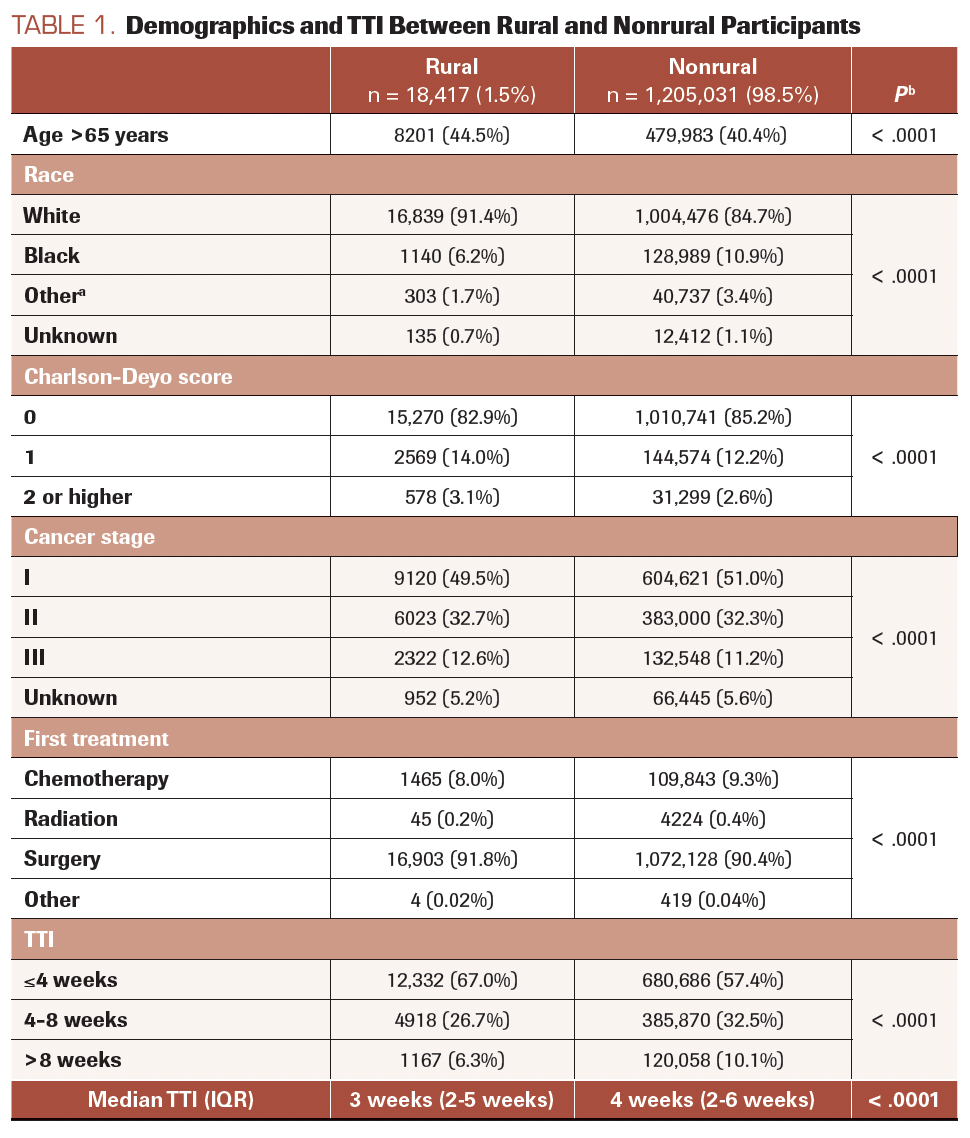
TABLE 1. Demographics and TTI Between Rural and Nonrural Participants
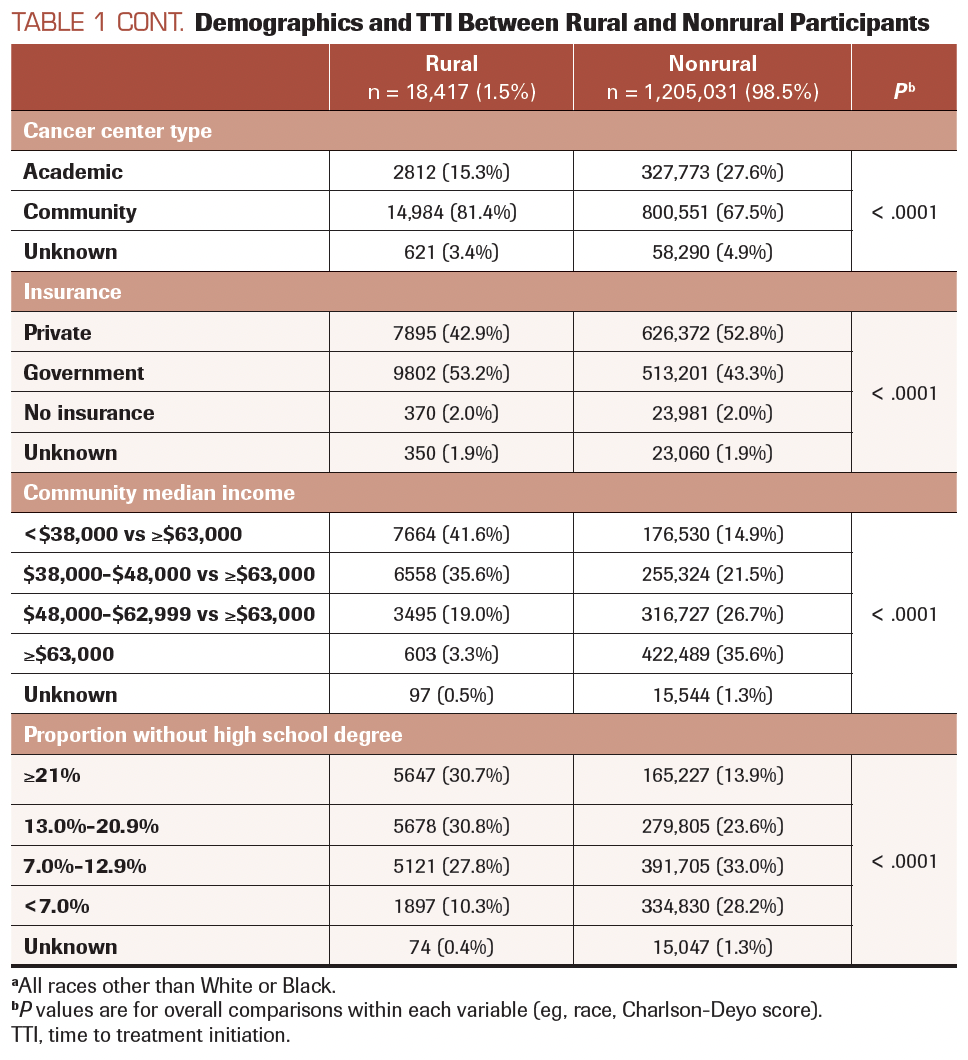
Methods
The study cohort was obtained from the NCDB, a joint program of the American Cancer Society and the Commission on Cancer (CoC) of the American College of Surgeons. The NCDB is a hospital-based, prospectively collected outcomes database that includes approximately 70% of all new invasive cancer diagnoses and more than 1500 CoC-accredited facilities in the United States. Data collection is standardized based on the Facility Oncology Registry Data Standards, and data were generated using the Participant Use Data File program. For this study, women diagnosed with stage I to III breast cancer between 2004 and 2012 were included; these were the most recent data available at the time of data abstraction. Because the data set is deidentified and publicly available, this study was granted exempt status by the institutional review board of the Cleveland Clinic Taussig Cancer Center.
Data abstracted included age, sex, race, community median income, insurance status, community education level, county urbanization, year of diagnosis, Amer-ican Joint Committee on Cancer stage, tumor grade, cancer center type, first treatment modality, and TTI. TTI was calculated using the dates of initial cancer diagnosis and earliest cancer-directed therapy (surgery, radiation, or systemic therapy). Level of comorbidity was measured using the Charlson-Deyo score.14
Patients were then categorized into rural and nonrural groups. Data on rural status were provided in the NCDB data set, which uses a classification schema based on county population size, degree of urbanization, and proximity to a metropolitan area. A rural community was defined either by having an urban population smaller than 2500 or by being completely rural. Urban counties included both urban and metropolitan counties as defined by the NCDB.
Statistical analyses evaluated associations between patient socioeconomic and disease attributes and TTI with OS. Baseline characteristics were summarized using percentages for categorical variables and medians with IQRs for continuous variables. TTI was divided into 3 categories: less than 4 weeks, 4 to 8 weeks, and greater than 8 weeks. OS was calculated from diagnosis to death or last follow-up, and an OS event was defined as death by any cause. OS was estimated using the Kaplan-Meier method. Survival time was censored for patients who were alive at the end of the study period.
Baseline characteristics between rural and nonrural groups were analyzed using the χ2 test for categorical variables and the Wilcoxon Rank Sum Test for continuous variables. The Cox proportional hazards model was used for univariate and multivariate regression analyses of OS, which included all baseline characteristics, rural vs nonrural status, and TTI as variables. The final multivariate Cox model was stratified by year of diagnosis. A 2-sided P value of less than .05 was used to indicate statistical significance. A summary of TTI (in weeks) by rural status and race was completed by using Wilcoxon Rank Sum Test. All data analyses were performed using SAS version 9.4 (SAS Institute; Cary, NC).
TABLE 2. Summary of TTI by Rural Status and Race, in Weeks
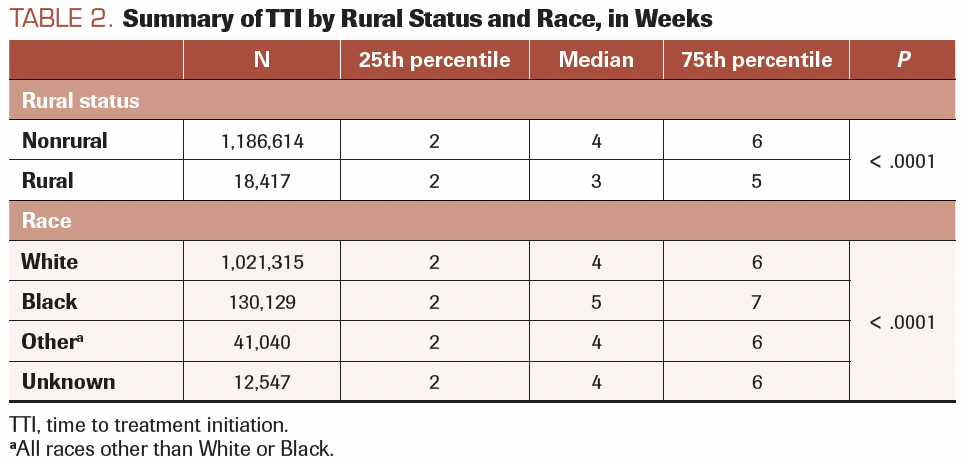
TABLE 3. Multivariate Regression for Overall Survival in Breast Cancer

Results
The study population was composed of 1,205,031 patients, 18,417 (1.5%) of whom were rural. The median follow-up of all included patients was 55.6 months (range, 0.1-133.3 months). Most patients did not have a prior history of cancer (85%); this included 84% of nonrural patients and 85% of rural patients. Most of our participants (55% rural; 60% nonrural) were 65 years or younger. Our study population was diagnosed predominantly with stage I (50% rural; 51% nonrural) and stage II (33% rural; 32% nonrural) breast cancer, and surgery was overwhelmingly the first treatment they received (92% rural; 90% nonrural). Higher proportions of rural vs nonrural patients were older than 65 years at diagnosis (45% vs 40%, respectively) and were White (91% vs 85%; P < .0001 for both). Compared with nonrural patients, rural patients were more likely to receive care at nonacademic centers (85% vs 72%, respectively), to have government insurance (53% vs 43%) and a median income less than $38,000 (42% vs 15%), and to live in less-educated communities (61% vs 38%; P < .0001 for all). These data are summarized in Table 1. Overall, Black patients had significantly longer TTI than White patients (Table 2).
While the data showed statistically significant differences in Charlson-Deyo score and breast cancer stage between rural and nonrural patients, these differences were small and not clinically meaningful. As depicted in Table 1, rural vs nonrural patients had shorter median TTI (3 vs 4 weeks, respectively; P < .0001). Additionally, more rural patients had TTI of less than 4 weeks (67% vs 57%) and less than 8 weeks (94% vs 90%; P <.0001 for both). Table 3 shows that a shorter TTI (both < 4 weeks vs 8 weeks and 4-8 weeks vs >8 weeks) was associated with improved OS (HR 0.84; 95% CI, 0.82-0.86; P < .0001; and HR 0.82; 95% CI, 0.81-0.83; P < .0001, respectively). As depicted in the Figure, shorter TTI improved outcomes for both rural and nonrural patients; this was more pronounced for rural patients earlier in follow-up (by 24-36 months) than for nonrural patients (by 48-60 months).
After adjusting for disease stage and demographic-, socioeconomic-, and treatment-related factors, rural status was associated with significantly better OS compared with nonrural status (HR, 0.92; 95% CI, 0.89-0.96; P < .0001). Other multivariable regression analyses are shown in Table 3 and a forest plot showing Cox model HRs is shown in the Figure.
FIGURE. Forest Plot of Estimated Hazard Ratios by Variables
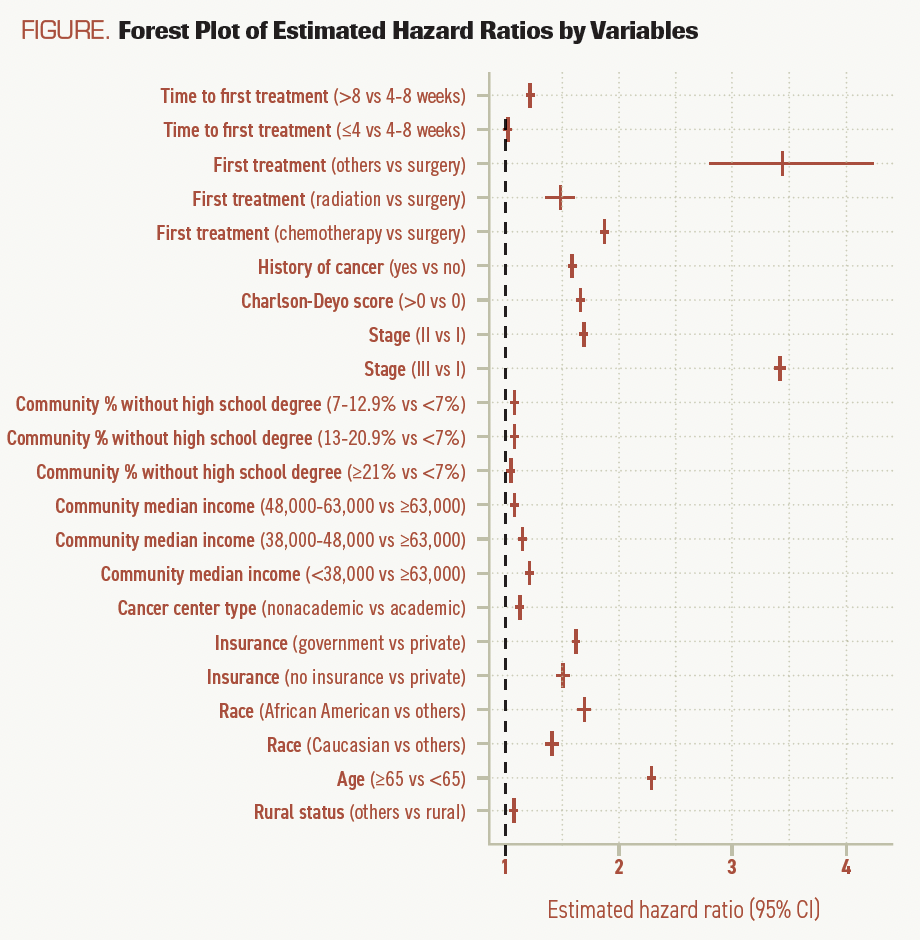
Discussion
Cancer mortality rates are generally higher in rural than nonrural populations in the United states.4,9 Many barriers exist for patients with cancer who live in rural communities.15 Consistent with our findings, previous studies have shown that rural patients are more likely to have lower income and to be less educated.15 These socioeconomic disparities can lead to low health literacy16,17 and being underinsured,18 and they can ultimately limit help-seeking behaviors. Geographically, patients living in rural settings often lack easy access to CoC-accredited facilities, including oncology specialty care and clinical trials.3 Unsurprisingly, rurality has been correlated with not obtaining guideline-directed care19 and is associated with more advanced cancer stage at diagnosis.20 For this reason, TTI has been used as a surrogate to measure access to care, with shorter intervals correlated with better outcomes.11 Increasingly, more studies have reported shorter time to diagnosis and TTI for rural patients with breast cancer than for those in urban areas.21-25 Our study also found that rural patients with breast cancer were statistically more likely to have better TTI than their urban counterparts. Additionally, we showed that delayed TTI correlated with worse outcomes, with the biggest difference in OS seen with a TTI of greater than 8 weeks.
Our results contrast with previous findings suggesting that rurality leads to delays in TTI for patients with breast cancer, resulting in poorer outcomes.12,13,26 The complexity of care for rural patients may offer possible reasons for these trends. Qualitative studies have looked at patient attitudes concerning the concept of choice of treatment provider and facilities. These studies have suggested that because of limited resources, provider/facility choice seem somewhat irrelevant for rural patients. Although there may be fewer options for treatment facilities in rural settings, those facilities may have more quickly available openings for new patients compared with some large metropolitan health systems.
Rural patients also noted limited capacity to obtain second opinions when it came to their treatment.27 The utilization of a second opinion has been reported to be higher in patients living in urban or metropolitan areas, those with higher socioeconomic status, and those who are privately insured.28-30 However, while there are potential benefits to obtaining a second opinion, the second opinion process can lead to delays in cancer treatment initiation.28 It is possible that rural patients in our study had shorter TTI in part because they were less likely to seek second opinions. However, this study did not directly measure utilization of second opinions. Given that patients with cancer increasingly seek second opinions and that the benefits of this process remain unclear,28 it would be important to characterize this process further among rural and nonrural patients to determine differences in TTI and outcomes.
Prior studies in breast cancer have demonstrated that Black and Hispanic women experience more treatment delays than White women, including delays of surgery and radiation as well as delayed or incomplete chemotherapy.31-37 Both our rural population and nonrural population predominantly included White women (91.4% and 84.7%, respectively), which is consistent with previously published data.35 In a study of 8860 adolescent and young-adult patients with breast cancer from the California Cancer Registry, 15.4% of Black women experienced delayed TTI compared with 8.1% of White women.36 It has been well documented that Black women with breast cancer are disproportionately affected by treatment delays,24,33,35,40 including of surgery38 and chemotherapy.32,42 One study that stratified TTI within a rural population found that Black women experienced longer TTI compared with their White counterparts.40 Our study showed that Black patients overall had significantly longer TTI. While our study showed that rural patients were more likely to have shorter TTI, an overwhelming majority of our rural population was White. These data suggest that while differences in outcomes exist for rural and nonrural patients, racial inequities may be an important factor in explaining why nonrural patients in our study had less favorable outcomes and TTI.
Limitations
We showed that the biggest decrease in OS was associated with TTI greater than 8 weeks for all patients, suggesting that delayed TTI is associated with worse OS. The difference in OS between TTI of less than 4 weeks and TTI of 4 to 8 weeks was statistically significant due to large sample size, but it is likely not clinically significant. Similarly, our study also found a statistically significant 1-week difference in median TTI among rural vs nonrural patients. Given that most patients in our study population presented with early stage I/II breast cancer and that most are estrogen receptor positive, it is unclear how clinically relevant this 1-week difference is to OS. Further research will need to evaluate whether factors such as aggressive subtypes or specific treatment modalities contribute to longer TTI. As there are no defined or validated TTI cutoffs, the cutoffs of 4 weeks and 8 weeks used in this study are arbitrary, although no more so than any others. Our study looked at TTI generally; future work may investigate the impact of times to initiation of specific treatments such as radiation, surgery, and neoadjuvant therapy.
As discussed, other variables—such as likelihood to seek second opinions, socioeconomic factors, and race—may also need to be explored further to fully understand the overall impact of these associations. We acknowledge that the NCDB relies on CoC-accredited hospitals, and these data may not be generalizable to all patients. Because of this, only 1.5% of our study population was composed of rural patients, compared with 18% in the general US population. Still, our findings help to define trends in a currently limited body of knowledge and to further the work in this field.
Additionally, future work may investigate data aggregated beyond 2012, particularly evaluating how the COVID-19 pandemic may have offset some factors causing disparities. One potential benefit is that during the pandemic, virtual visits became more widely available, particularly for patients who lived far from their providers. Still, rural patients are less likely to have adequate connectivity, and thus the ability of telehealth to equalize the level of access for rural and nonrural patients remains to be seen. If issues of connectivity to state-of-the art cancer care, timely second opinions, and access to subspecialists can be mitigated by telehealth, it is reasonable to be optimistic about its role in eliminating some rural health disparities.41 Until then, strategies that aim to shorten TTI using results from this study and other studies may provide a timely impact on eliminating rural health disparities.
Conclusions
Our study adds to a growing body of literature aimed at informing strategies that can be easily reapplied to other institutions. This study demonstrates that despite many adverse clinical and socioeconomic factors, rural women with early-stage breast cancer experience shorter TTI and better outcomes compared with urban women—this is particularly true for those with a TTI of less than 8 weeks. Our findings highlight the complexity of rural health disparities, particularly issues pertaining to access. Additionally, our study results suggest not only that TTI correlates with survival outcomes, but also that understanding these trends may help to facilitate much-needed strategies to reduce health disparities for rural patients with breast cancer. In an era when novel cancer therapies that provide survival advantages of several months (or more) are rapidly changing national guidelines, it is worth considering the connection between shortened TTI and improved OS.
DISCLOSURE: AAK has served as a consultant for Anthos, Bayer, Bristol Myers Squibb, Janssen Pharmaceuticals, Pfizer, and Sanofi; SDK has served as a consultant or paid advisory board member for Exelixis and Tempus.
AUTHOR AFFILIATIONS:
Minh-Tri Nguyen, MD1; Wei Wei, MS2; Gregory Cooper, MD3; Alok A. Khorana, MD4; and Suneel D. Kamath, MD5
1Cleveland Clinic Taussig Cancer Institute, Cleveland, OH; Nguyenm8@ccf.org
2Cleveland Clinic Department of Quantitative Health Science, Cleveland, OH; weiw2@ccf.org
3Case Western Reserve University School of Medicine, Cleveland, OH; Gregory.Cooper@uhhospitals.org
4Cleveland Clinic Taussig Cancer Institute, Cleveland, OH; khorana@ccf.org
5Cleveland Clinic Taussig Cancer Institute, Cleveland, OH; kamaths@ccf.org
CORRESPONDING AUTHOR:
Minh-Tri Nguyen, MD
9500 Euclid Ave, CA6
Cleveland, OH 44195
216-444-7923
Email: Nguyenm8@ccf.org
Twitter: @MinhTriMD
REFERENCES
- Lin CC, Bruinooge SS, Kirkwood MK, et al. Association between geographic access to cancer care, insurance, and receipt of chemotherapy: geographic distribution of oncologists and travel distance. J Clin Oncol. 2015;33(28):3177-3185. doi:10.1200/JCO.2015.61.1558
- Rocque GB, Williams CP, Miller HD, et al. Impact of travel time on health care costs and resource use by phase of care for older patients with cancer. J Clin Oncol. 2019;37(22):1935-1945. doi:10.1200/JCO.19.00175
- Levit LA, Byatt L, Lyss AP, et al. Closing the rural cancer care gap: three institutional approaches. JCO Oncol Pract. 2020;16(7):422-430. doi:10.1200/OP.20.00174
- Blake KD, Moss JL, Gaysynsky A, Srinivasan S, Croyle RT. Making the case for investment in rural cancer control: an analysis of rural cancer incidence, mortality, and funding trends. Cancer Epidemiol Biomarkers Prev. 2017;26(7):992-997. doi:10.1158/1055-9965.EPI-17-0092
- Chandak A, Nayar P, Lin G. Rural-urban disparities in access to breast cancer screening: a spatial clustering analysis. J Rural Health. 2019;35(2):229-235. doi:10.1111/jrh.12308
- Doescher MP, Jackson JE. Trends in cervical and breast cancer screening practices among women in rural and urban areas of the United States. J Public Health Manag Pract. 2009;15(3):200-209. doi:10.1097/PHH.0b013e3181a117da
- Nguyen-Pham S, Leung J, McLaughlin D. Disparities in breast cancer stage at diagnosis in urban and rural adult women: a systematic review and meta-analysis. Ann Epidemiol. 2014;24(3):228-235. doi:10.1016/j.annepidem.2013.12.002
- Henley SJ, Anderson RN, Thomas CC, Massetti GM, Peaker B, Richardson LC. Invasive cancer incidence, 2004-2013, and deaths, 2006-2015, in nonmetropolitan and metropolitan counties - United States. MMWR Surveill Summ. 2017;66(14):1-13. doi:10.15585/mmwr.ss6614a1
- Moy E, Garcia MC, Bastian B, et al. Leading causes of death in nonmetropolitan and metropolitan areas - United States, 1999-2014. MMWR Surveill Summ. 2017;66(1):1-8. doi:10.15585/mmwr.ss6601a1
- Yaemsiri S, Alfier JM, Moy E, et al. Healthy People 2020: rural areas lag in achieving targets for major causes of death. Health Aff (Millwood). 2019;38(12):2027-2031. doi:10.1377/hlthaff.2019.00915
- Bolwell BJ, Khorana AA. Enhancing value for patients with cancer: time to treatment as a surrogate for integrated cancer care. J Natl Compr Canc Netw. 2016;14(1):115-116. doi:10.6004/jnccn.2016.0010
- Bleicher RJ, Ruth K, Sigurdson ER, et al. Time to surgery and breast cancer survival in the United States. JAMA Oncol. 2016;2(3):330-339. doi:10.1001/jamaoncol.2015.4508
- Khorana AA, Tullio K, Elson P, et al. Time to initial cancer treatment in the United States and association with survival over time: an observational study. PLoS One. 2019;14(3):e0213209. doi:10.1371/journal.pone.0213209. Published correction appears in PLoS One. 2019;14(4):e0215108.
- Charlson ME, Pompei P, Ales KL, MacKenzie CR. A new method of classifying prognostic comorbidity in longitudinal studies: development and validation. J Chronic Dis. 1987;40(5):373-383. doi:10.1016/0021-9681(87)90171-8
- Yabroff KR, Han X, Zhao J, Nogueira L, Jemal A. Rural cancer disparities in the United States: a multilevel framework to improve access to care and patient outcomes. JCO Oncol Pract. 2020;16(7):409-413. doi:10.1200/OP.20.00352
- Zahnd WE, Scaife SL, Francis ML. Health literacy skills in rural and urban populations. Am J Health Behav. 2009;33(5):550-557. doi:10.5993/ajhb.33.5.8
- Douthit N, Kiv S, Dwolatzky T, Biswas S. Exposing some important barriers to health care access in the rural USA. Public Health. 2015;129(6):611-620. doi:10.1016/j.puhe.2015.04.001
- Henley SJ, Jemal A. Rural cancer control: bridging the chasm in geographic health inequity. Cancer Epidemiol Biomarkers Prev. 2018;27(11):1248-1251. doi:10.1158/1055-9965.EPI-18-0807
- Tropman SE, Ricketts TC, Paskett E, Hatzell TA, Cooper MR, Aldrich T. Rural breast cancer treatment: evidence from the Reaching Communities for Cancer Care (REACH) project. Breast Cancer Res Treat. 1999;56(1):59-66. doi:10.1023/a:1006279117650
- Obeng-Gyasi S, Timsina L, Bhattacharyya O, Fisher CS, Haggstrom DA. Breast cancer presentation, surgical management and mortality across the rural-urban continuum in the National Cancer Database. Ann Surg Oncol. 2020;27(6):1805-1815. doi:10.1245/s10434-020-08376-y
- Robertson R, Campbell NC, Smith S, et al. Factors influencing time from presentation to treatment of colorectal and breast cancer in urban and rural areas. Br J Cancer. 2004;90(8):1479-1485. doi:10.1038/sj.bjc.6601753
- Bergin RJ, Emery J, Bollard RC, et al. Rural-urban disparities in time to diagnosis and treatment for colorectal and breast cancer. Cancer Epidemiol Biomarkers Prev. 2018;27(9):1036-1046. doi:10.1158/1055-9965.EPI-18-0210
- Caplan LS, May DS, Richardson LC. Time to diagnosis and treatment of breast cancer: results from the National Breast and Cervical Cancer Early Detection Program, 1991-1995. Am J Public Health. 2000;90(1):130-134. doi:10.2105/ajph.90.1.130
- Sheinfeld Gorin S, Heck JE, Cheng B, Smith SJ. Delays in breast cancer diagnosis and treatment by racial/ethnic group. Arch Intern Med. 2006;166(20):2244-2252. doi:10.1001/archinte.166.20.2244
- Richardson LC, Royalty J, Howe W, Helsel W, Kammerer W, Benard VB. Timeliness of breast cancer diagnosis and initiation of treatment in the National Breast and Cervical Cancer Early Detection Program, 1996-2005. Am J Public Health. 2010;100(9):1769-1776. doi:10.2105/AJPH.2009.160184
- Bleicher RJ. Timing and delays in breast cancer evaluation and treatment. Ann Surg Oncol. 2018;25(10):2829-2838. doi:10.1245/s10434-018-6615-2
- Bergin R, Emery J, Bollard R, White V. How rural and urban patients in Australia with colorectal or breast cancer experience choice of treatment provider: a qualitative study. Eur J Cancer Care (Engl). 2017;26(6). doi:10.1111/ecc.12646
- Hillen MA, Medendorp NM, Daams JG, Smets EMA. Patient-driven second opinions in oncology: a systematic review. Oncologist. 2017;22(10):1197-1211. doi:10.1634/theoncologist.2016-0429
- Fedewa SA, Edge SB, Stewart AK, Halpern MT, Marlow NM, Ward EM. Race and ethnicity are associated with delays in breast cancer treatment (2003-2006). J Health Care Poor Underserved. 2011;22(1):128-141. doi:10.1353/hpu.2011.0006
- Emerson MA, Golightly YM, Aiello AE, et al. Breast cancer treatment delays by socioeconomic and health care access latent classes in Black and White women. Cancer. 2020;126(22):4957-4966. doi:10.1002/cncr.33121
- Sheppard VB, Oppong BA, Hampton R, et al. Disparities in breast cancer surgery delay: the lingering effect of race. Ann Surg Oncol. 2015;22(9):2902-2911. doi:10.1245/s10434-015-4397-3
- Green AK, Aviki EM, Matsoukas K, Patil S, Korenstein D, Blinder V. Racial disparities in chemotherapy administration for early-stage breast cancer: a systematic review and meta-analysis. Breast Cancer Res Treat. 2018;172(2):247-263. doi:10.1007/s10549-018-4909-5
- Akinyemiju T, Moore JX, Ojesina AI, Waterbor JW, Altekruse SF. Racial disparities in individual breast cancer outcomes by hormone-receptor subtype, area-level socio-economic status and healthcare resources. Breast Cancer Res Treat. 2016;157(3):575-586. doi:10.1007/s10549-016-3840-x
- Parekh A, Fu W, Hu C, et al. Impact of race, ethnicity, and socioeconomic factors on receipt of radiation after breast conservation surgery: analysis of the National Cancer Database. Breast Cancer Res Treat. 2018;172(1):201-208. doi:10.1007/s10549-018-4881-0
- Cromartie J. Rural America at a Glance, 2018 Edition. Economic Research Service, US Department of Agriculture. November 2018. Accessed January 5, 2022. Available at: https://www.ers.usda.gov/publications/pub-details/?pubid=90555
- Smith EC, Ziogas A, Anton-Culver H. Delay in surgical treatment and survival after breast cancer diagnosis in young women by race/ethnicity. JAMA Surg. 2013;148(6):516-523. doi:10.1001/jamasurg.2013.1680
- Hoppe EJ, Hussain LR, Grannan KJ, Dunki-Jacobs EM, Lee DY, Wexelman BA. Racial disparities in breast cancer persist despite early detection: analysis of treatment of stage 1 breast cancer and effect of insurance status on disparities. Breast Cancer Res Treat. 2019;173(3):597-602. doi:10.1007/s10549-018-5036-z
- Bekeny JC, Luvisa K, Wirth P, et al. Critical evaluation of factors contributing to time to mastectomy within a single health care system. Breast J. 2020;26(9):1702-1711. doi:10.1111/tbj.13953
- Fedewa SA, Ward EM, Stewart AK, Edge SB. Delays in adjuvant chemotherapy treatment among patients with breast cancer are more likely in African American and Hispanic populations: a national cohort study 2004-2006. J Clin Oncol. 2010;28(27):4135-4141. doi:10.1200/JCO.2009.27.2427
- Babatunde OA, Eberth JM, Felder TM, et al. Racial disparities and diagnosis-to-treatment time among patients diagnosed with breast cancer in South Carolina. J Racial Ethn Health Disparities. 2022;9(1):124-134. doi:10.1007/s40615-020-00935-z
- DeGuzman PB, Bernacchi V, Cupp CA, et al. Beyond broadband: digital inclusion as a driver of inequities in access to rural cancer care. J Cancer Surviv. 2020;14(5):643-652. doi:10.1007/s11764-020-00874-y
